Some key insights from the article:
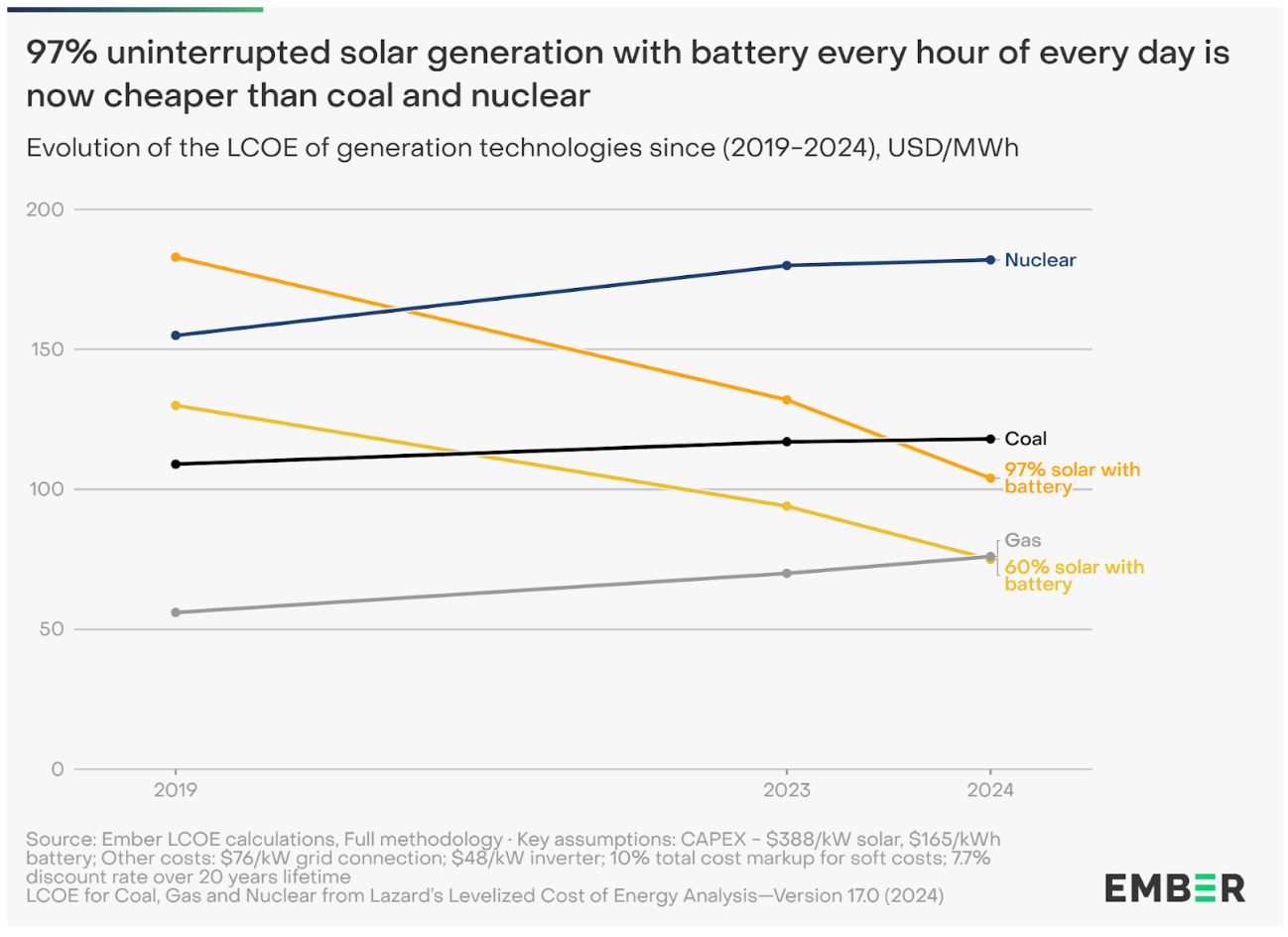
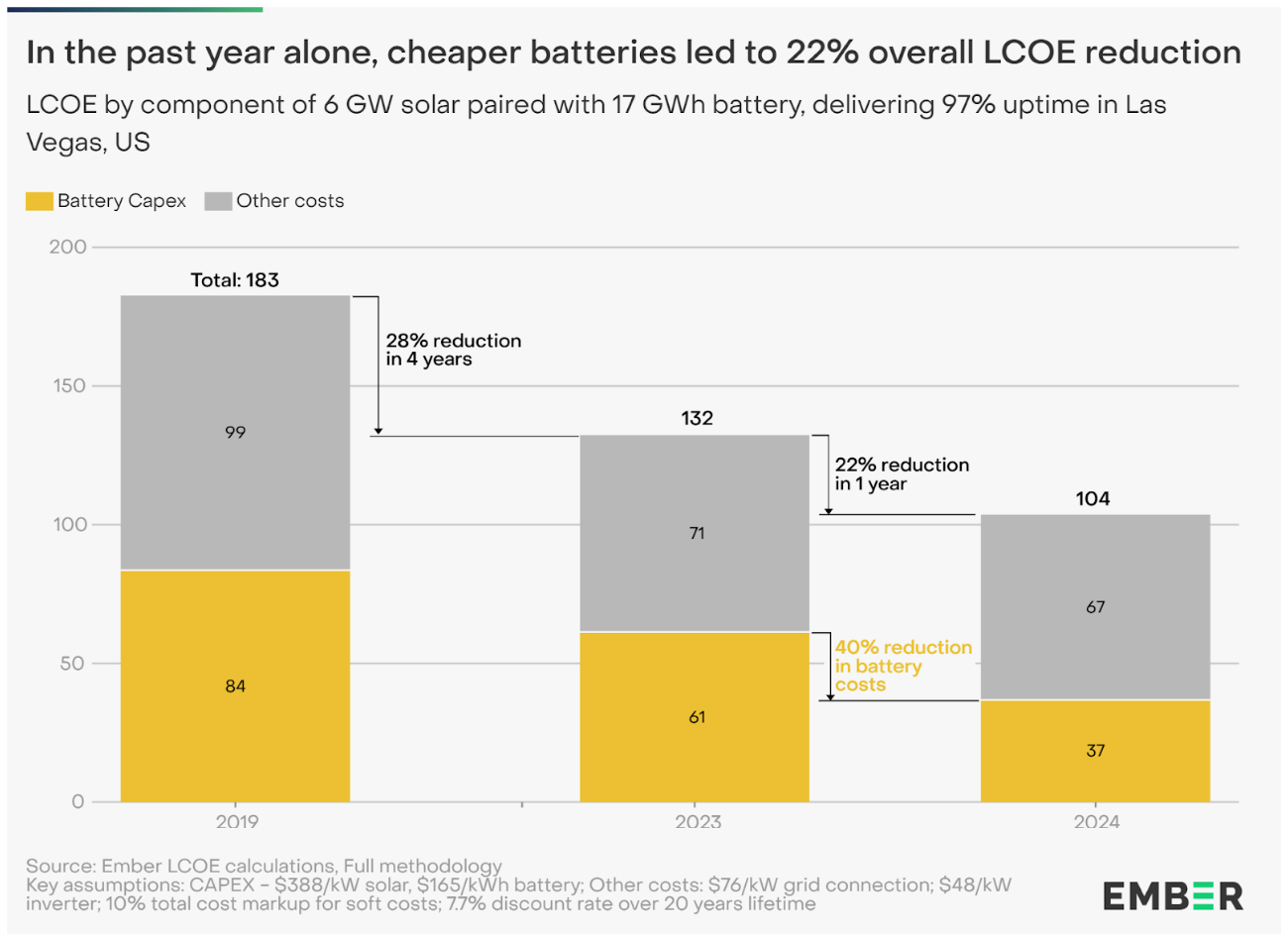
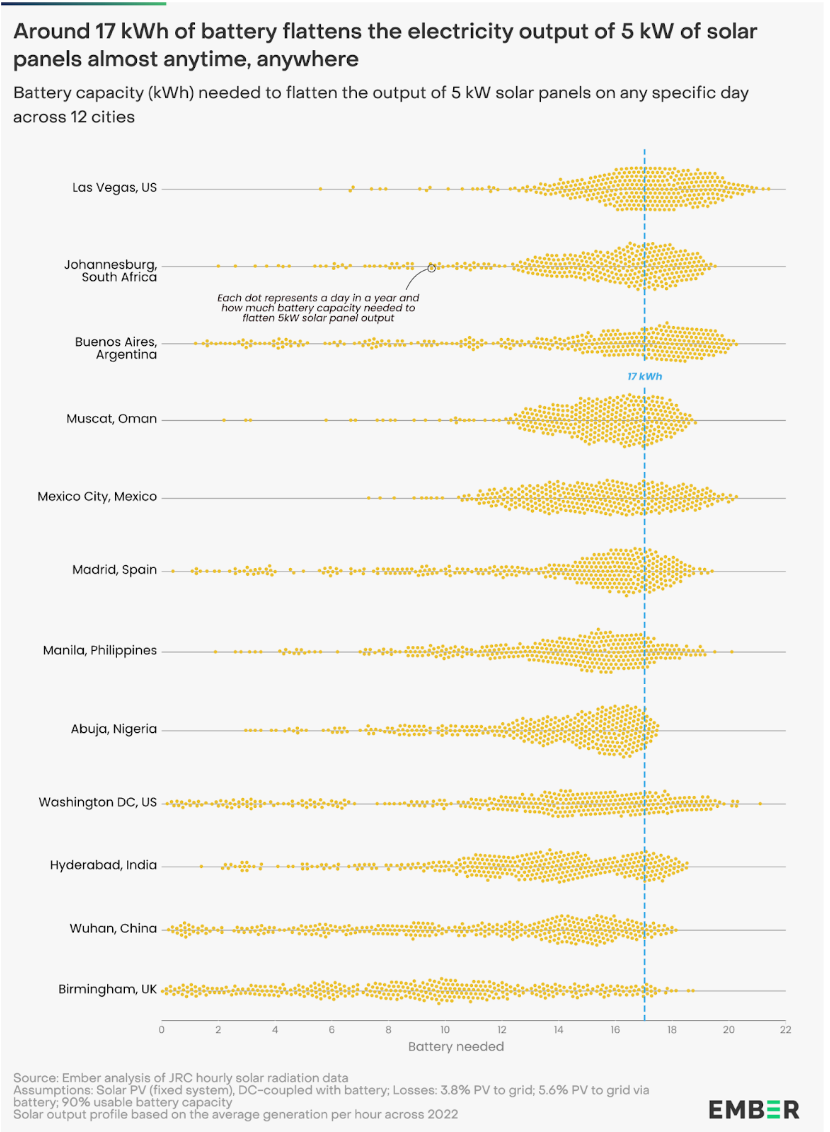
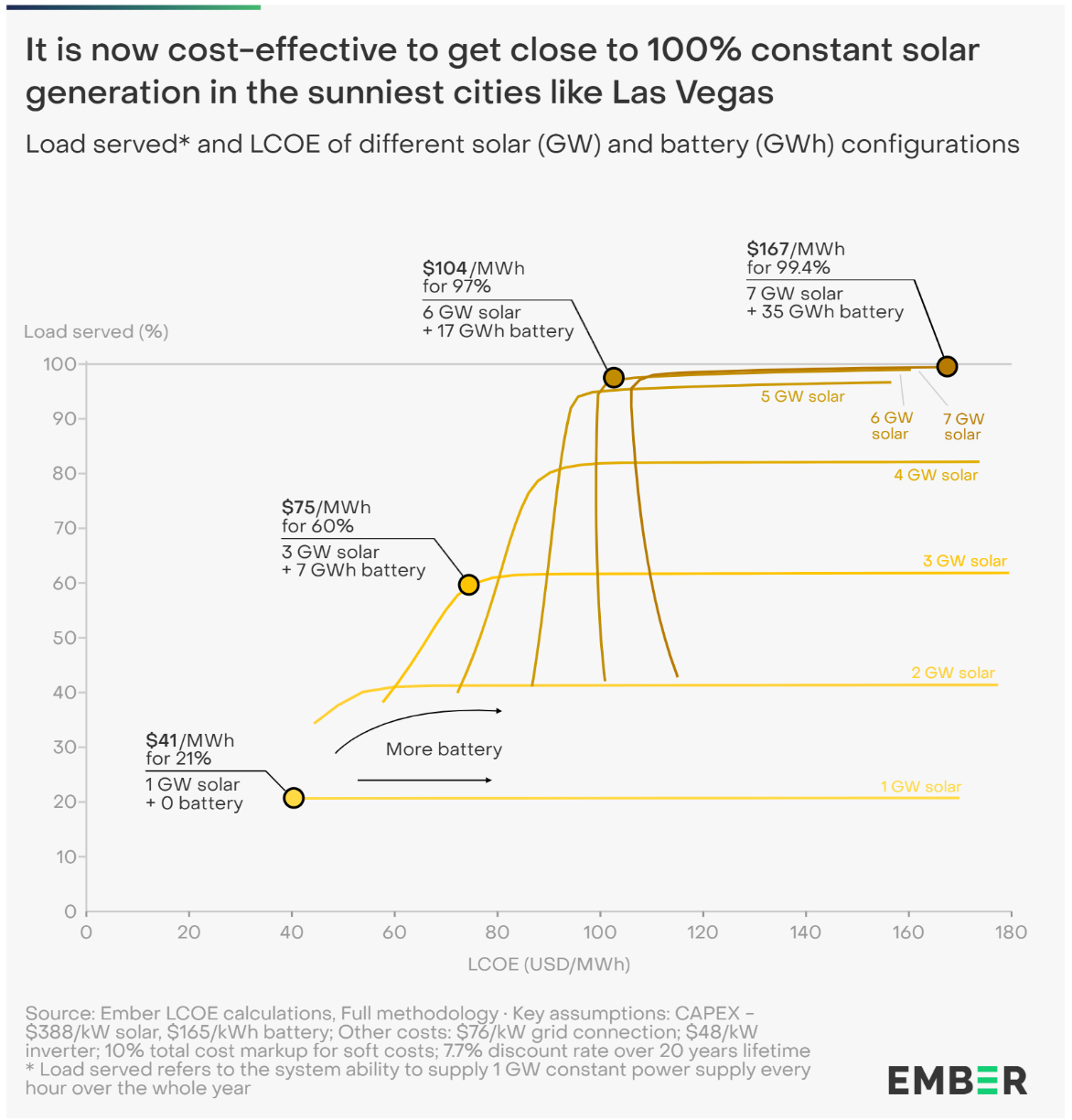
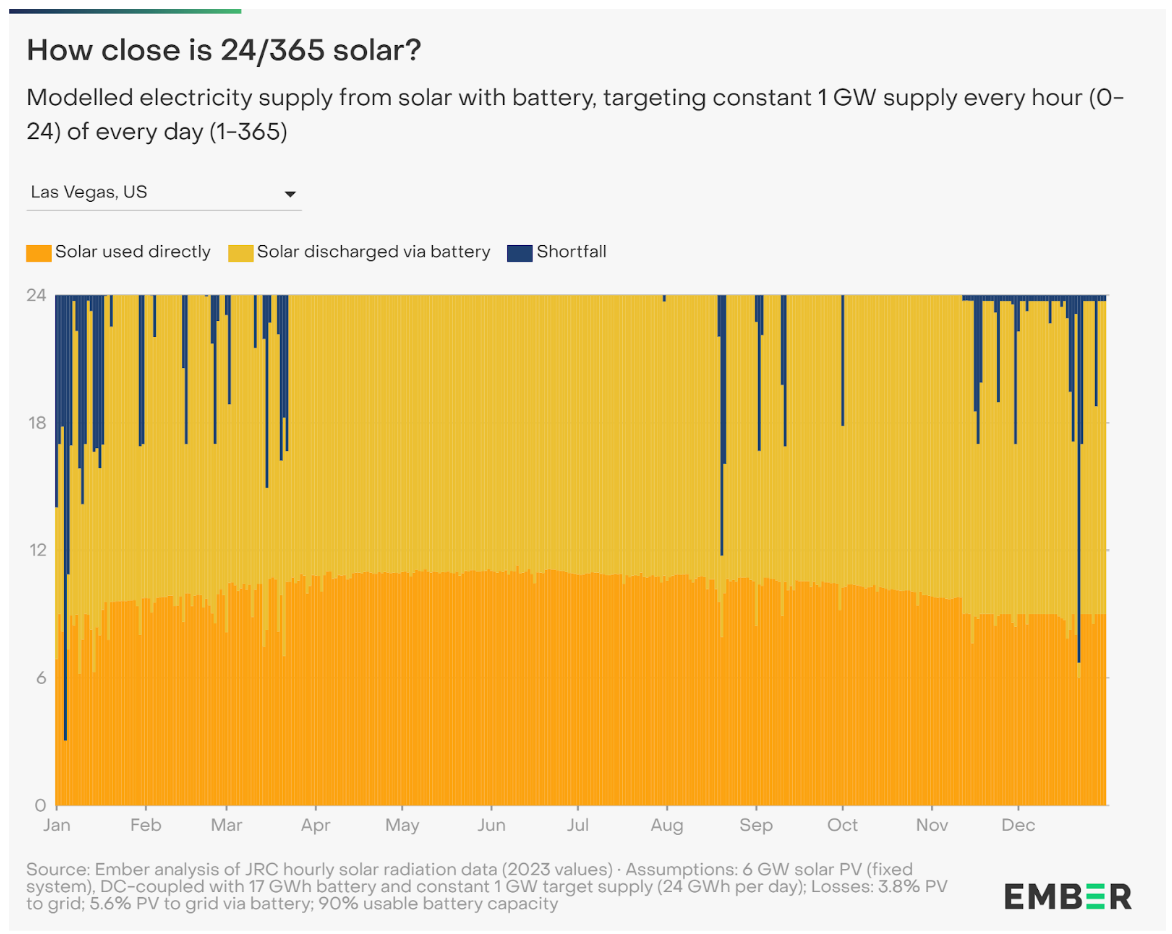
Basically, what they did was to look at how much batteries would be needed in a given area to provide constant power supply at least 97% of the time, and the calculate the costs of that solar+battery setup compared to coal and nuclear.
This is US centric, and panels are 1/3 cost in China, batteries 1/2, and labour/land 1/2 ish too.
just 17 kWh of battery storage is enough to turn 5 kW of solar panels into a steady 1 kW of 24-hour clean power
This is a bad model, though they are saying 3.4 hours of storage, and LasVegas as their best site. AC use is typically day only, but heat waves do make it a 24 hour demand issue on the longest solar production days. For LV, 5kw of solar will produce 32kwh/day, ranging in seasons from 29-35.5kwh. Already a problem for their 1kw “transmission setup” in that production is higher. The 2nd problem is that there is/can be higher demand during the day than night, due to AC.
The biggest problem of all is a battery in LV, even with 2kw transmission per 5kw solar, would charge in winter up to 19kwh of batteries. Summer 21.5kwh. The 2 big variables are batteries vs transmission size, and demand shifting opportunities, where necessarily fully charging batteries every day is a cost optimization, though fully delivering power on highest demand days is a revenue/price optimization.
cost assumptions are $563/kw solar-electrical hardware, and $181/kwh batteries. They may not include land and deployment costs. They use outdated pessimistic 20 year lifetimes. They have terrible comparisons to coal and NG as well.
Both coal and NG plants cost the same for basic peaker plant. A double efficient NG plant costs double, but loses flexibility. They have variable fuel costs and relatively fixed operation costs. Before covid, all 3 options cost $1/watt to build, giving a huge advantage to solar for not having fuel/operations costs.
A much easier way to model cost of solar+battery system is independently. Solar at $563/kw in LV to make 10% “yield” per year (covering full financing and a healthy profit). needs $56.30 revenue/year = 2.4c/kwh = $24/mwh. Even $1/w US system requires 4.27c/kwh The same base profit over operational costs as FF plants. Batteries last 30 years too, and 10% yield means a discharge/charge profit requirement of 5c/kwh at night, with possible double cycling from clouds/frequency balancing, or lunch cooking demand spike, where any profit is bonus profit.
So as long as duck curve/early evening/morning breakfast electricity markets are 7.4c/kwh TOU "wholesale"rates or higher, and daytime rates above 2.4c/kwh, solar + batteries (that fully charge every day) then that far beats any new dead ender energy plants. Also, for a 1gw transmission line, compared to OP model, you only need 1.7gw solar instead of 5gw.
In short term there are existing FF plants that can serve as backup, and where it is extremely undesirable to have any human activity in their surrounding areas, host solar to piggy back on their transmission capacity. That these plants were paid 20-40c/kwh to provide 10%-20% of power needs, with a combination of per kwh pricing, and fixed “stay ready for backup” payments, would permit these plants to stay open/operational. In short/medium term, EVs are a great resource to replace both utility batteries, and backup FF plants with more solar. Being paid 3-10c/kwh profit (depending on demand primarily from nightime AC/heating)
In long term, the path to solar+battery/EV power every day is much more solar with H2 electrolysis. $2/kg costs are already achievable today with 2c/kwh “surplus solar” input. It is an even more rapidly advancing tech/cost efficiency field. $2/kg is equivalent for a FCEV to $1/gallon gasoline vehicle range. It is 6c/kwh CHP (free domestic hot water energy), and 10c/kwh electric only energy, in addition to many chemical applications such as local fertilizer production. Electrolysis of NG is a more efficient (than water electrolysis) green H2 process that produces carbon black as byproduct. A solid precursor to graphene and battery electrodes.
H2 works today for places outside LV, where solar is much more variable. In Canada where long summer days may not need AC, high saturation solar can drop below 2c/kwh for 9 months, but be worth 15c/kwh for 80-90 days. A balance between existing energy systems and new solar works everywhere in the world. H2 export/import infrastructure also cost efficiently displaces much FF energy.
As long as daytime wholesale electricity rates in LV are above 2.4c/kwh, they need more solar. A similar number can be calculated elsewhere. Nuclear and more expensive combined NG energy cannot compete because daytime solar will cut into the hours they can sell energy.
As others have said this is for Las Vegas which receives wayyy more sun than the average place. But the other misleading part is they looked at 20 years which is close to the life cycle for solar/batteries and not even half the life of nuclear
But the other misleading part is they looked at 20 years which is close to the life cycle for solar/batteries and not even half the life of nuclear
I think Lazard’s LCOE methodology looks at the entire life cycle of the power plant, specific to that power plant. So they amortize solar startup/decommissioning costs across the 20 year life cycle of solar, but when calculating LCOE for nuclear, they spread the costs across the 80 year life cycle of a nuclear plant.
Nuclear is just really, really expensive. Even if plants required no operating costs, the up front costs are so high that it represents a significant portion of the overall operating costs for any given year.
The Vogtle debacle in Georgia cost $35 billion to add
2 MW2GW (edit to fix error) of capacity. They’re now projecting that over the entire 75 year lifespan the cost of the electricity will come out to be about $0.17 to $0.18 per kilowatt hour.they looked at 20 years which is close to the life cycle for solar/batteries and not even half the life of nuclear
Brother, with some luck a nuclear plant is in construction stage after those 20 years
China has been doing them in around 7 years from groundbreaking to grid connection and is trying to get that down to 5 years with their bailong power plant as they are developing an experienced work force and actually have experience making the parts
97% sounds impressive, but thats equivalent to almost an hour of blackout every day. Developed societies demand +99.99% availability from their grids.
Then get it from the sources that already exist. 97% coverage is a great milestone.
Funny enough lots of people hate that. Lots of people have binary thinking, it’s either 100% coal or 100% solar.


